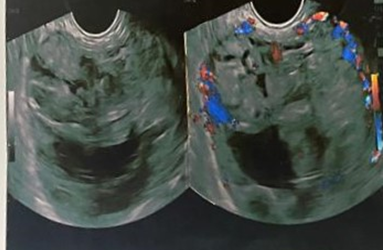MOJ
eISSN: 2475-5494


Case Report Volume 12 Issue 3
1Resident, Department of Obstetrics and Gynecology, Lady Hardinge Medical College and Associated Hospitals, New Delhi
2Professor, Department of Obstetrics and Gynecology, Lady Hardinge Medical College and Associated Hospitals, New Delhi
3Director Professor, Department of Obstetrics and Gynecology, Lady Hardinge Medical College and Associated Hospitals, New Delhi
Correspondence: Swati Agrawal, Professor, Department of Obstetrics and Gynecology, Lady Hardinge Medical College and Associated Hospitals, New Delhi, India, Tel 09810189164
Received: September 01, 2023 | Published: September 15, 2023
Citation: Arora I, Agrawal S, Biswas R, et al. Conservative management of Caesarean scar site ectopic pregnancy with morbidly adherent placenta: a challenging scenario. MOJ Women’s Health. 2023;12(3):67-68. DOI: 10.15406/mojwh.2023.12.00320
Pregnancy that is implanted on or in a scar from a past caesarean birth is known as a caesarean scar pregnancy (CSP). It may result in significant rates of morbidity such as haemorrhage, uterine rupture, and placenta accreta spectrum [PAS] as well as maternal mortality. CSP may be managed medically or by surgical intervention depending on the condition of the patient. We present a rare case of an advanced CSP which was successfully managed with medical management with intra-sac and systemic methotrexate.
Keywords: ectopic pregnancy, haemorrhage, uterine rupture, amenorrhea
CSP, caesarean scar pregnancy; PAS, placenta accreta spectrum
Caesarean Scar site ectopic pregnancy is defined as implantation in defect of previous uterine incision. Although rare, the incidence of this condition is increasing due to increasing caesarean sections rates globally. The prevalence of caesarean ectopic pregnancy is estimated to be one in 2,000 pregnancies, which could be potential viable pregnancies or miscarriages into the scar.1
A 31 year old lady Gravida 4 Para 3 Live birth 1 with history of previous 3 caesarean sections presented to the outpatient department at 3 months amenorrhea for routine antenatal checkup. Physical examination demonstrated stable vital signs while bimanual examination revealed an enlarged uterus corresponding to 12 weeks gestation with no adnexal masses. Transvaginal ultrasound revealed a single live intrauterine gestational sac occupying the lower segment of uterus corresponding to 11+2 weeks period of gestation, along with placenta seen in lower part of uterus covering os and invading the scar site which was suggestive of caesarean scar site ectopic pregnancy. No free fluid was seen in posterior cul de sac. MRI revealed a single intrauterine fetus with heterogenous placental mass measuring 72*89*81 mm along with focal area of loss of placental myometrial vesical interface with prominent intervening vascular channels with prominent flow voids on T2 weighted image Figures 1 & 2.

Figure 2 MRI PELVIS depicting focal area of placental myometrial vesical interface with prominent intervening vascular channels with prominent flow voids on T2 weighted image.
Initial beta hcg (ß-subunit of human chorionic gonadotrophin) was 15,000 mIU/mL. Since the patient was asymtomatic and haemodyanamically stable but had deranged blood sugar levels which made her high risk for surgical intervention, decision for conservative management was taken. Twenty five mg of methotrexate was administered intracardiac under ultrasound guidance (DAY 1) followed by systemic (intramuscular) methotrexate 25 mg on DAY 4 and DAY 10. Serial monitoring of beta hcg was done. An initial rise of 60 % from baseline value of beta hcg was noticed 2 days after intracardiac methotrexate which was followed by 20%, 50 % and 90% fall from initial values in next 3 weekly measured values. Patient was asked to follow up with weekly beta hcg till values negative and monthly ultrasound imaging. Two month after methotrexate administration review ultrasound was done for the patient which revealed significant reduction in the size of mass in lower uterine segment from 7.2*8.9*8.1 cm to 6.6*6.4*4.6 cm with absent vascularity with normal beta hcg (2.61 mIU/ML). There was complete resolution of the mass and the patient resumed her normal periods 4 months after the treatment.
Caesarean Scar site ectopic pregnancy with morbidly adherent placenta is a challenging scenario in terms of diagnosis and management. It has the potential to lead to substantial maternal morbidity and mortality. There is no clear consensus on the best management option for this condition.2 Decision for definitive surgery versus medical management needs to be decided taking in account the size of the pregnancy, general condition of the patient as well compliance of the patient. For medical management, methotrexate is the most commonly used drug which can be given systemic or intramuscular, as local or intrasac injection, or a combination of both. Surgical options include hysteroscopic evacuation and curettage, laparoscopic or open scar excision, and hemostatic treatments such as tamponade and uterine artery embolization.3 However, surgical management carries an inherent of risk for torrential life threatening haemorrhage, ICU stay, multiple blood transfusion, organ injury and need for mechanical ventilation. A study by Fadhlaopoui et al.,4 has shown that a viable caesarean scar site ectopic pregnancy can be effectively managed with conservative treatment like systemic methotrexate and dilation and curettage.4 Uterine artery embolization can also be coupled with local injection of methotrexate for the management as demonstrated in a study by Tulpin et al.5
The present case report is rare and interesting as successful medical management of scar ectopic pregnancy at such advanced gestation has not been reported in literature. The process of resolution of the ectopic mass may be slow and it is imperative that the patient is kept under close follow up so that complications such as sepsis and haemorrhage may be picked up and treated promptly.
None.
The authors declares that there is no conflict of interest.

©2023 Arora, et al. This is an open access article distributed under the terms of the, which permits unrestricted use, distribution, and build upon your work non-commercially.